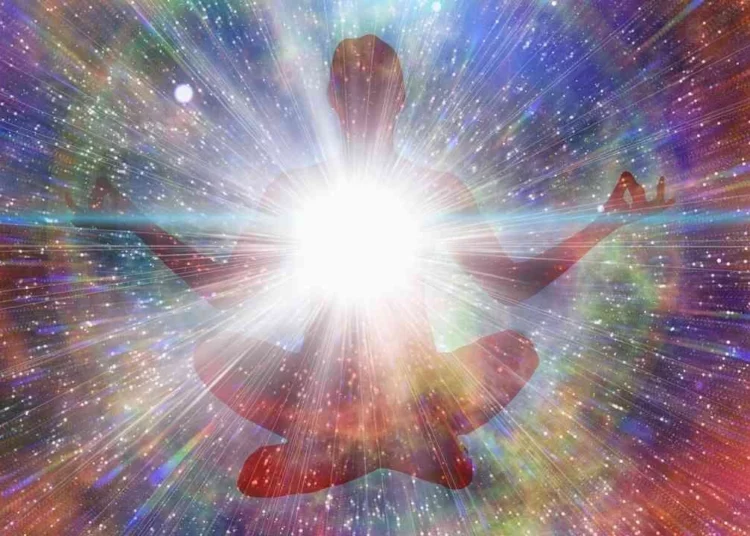Understanding Auras: What You Need to Know
An aura is an energy field that surrounds all living things. It is believed that every individual has an aura, and it can be seen by those who have developed their psychic abilities or through the use of special equipment. The aura is said to contain information about a person’s physical, emotional, and spiritual well-being.
The colors of the aura are thought to represent different aspects of a person’s personality and state of being. Understanding your own aura and those of others can help you better understand yourself and your relationships with others.
What Does an Aura Look Like?
An aura typically appears as a colorful, luminous field surrounding a person’s body. The colors can vary in intensity and hue depending on the individual’s mood, health, and other factors. Some people may see the aura as a solid color while others may see it as a series of layers or bands.
How Can You See an Aura?
To see an aura, one must develop their psychic abilities or use special equipment such as Kirlian photography. Kirlian photography captures images of the energy fields surrounding living things using high-voltage electrical discharges.
The Significance of a White Aura and What It Means
A white aura is often associated with purity, clarity, and enlightenment. Those with a white aura are said to possess strong spiritual connections and have a deep understanding of themselves and their place in the world.
What Are Some Characteristics of Those With a White Aura?
- Highly intuitive
- Spiritually connected
- Possess clear communication skills
- Calm under pressure
- Have a strong sense of purpose
What Are Some Challenges Those With a White Aura May Face?
While those with a white aura are often seen as enlightened, they may also face challenges such as:
- Feeling disconnected from others who do not share their level of spiritual understanding
- Struggling to communicate their thoughts and feelings to others who do not possess the same level of clarity
- Becoming overwhelmed by negative energies or emotions from others
- Feeling isolated or misunderstood
Exploring the Colors of Auras: Can You Have More Than One?
Understanding the Concept of Multiple Auras
The idea of having multiple auras is not uncommon in spiritual and metaphysical circles. Some believe that each person has multiple layers of energy fields that make up their aura, with each layer representing different aspects of their being. For example, the physical layer may represent the body, while the emotional layer may represent feelings and emotions.
The Different Layers of the Aura
According to some beliefs, there are seven main layers of the aura:
1. The physical layer
2. The emotional layer
3. The mental layer
4. The astral layer
5. The etheric template layer
6. The celestial layer
7. The ketheric template or causal layer
Each of these layers is said to have its own unique color and vibration.
Can You Have Multiple Aura Colors?
While some believe that each aura layer has its own color, others believe that a person can have more than one aura color at once. This is because a person’s aura can change depending on their mood, emotions, and overall energy level.
For example, someone who is feeling happy and content may have a bright yellow or orange aura, while someone who is feeling sad or depressed may have a darker blue or purple aura.
It’s also possible for a person to have multiple colors present in their aura at once. For example, someone who is feeling both happy and creative may have a mix of yellow and green in their aura.
Ultimately, whether or not you can have more than one aura color depends on your personal beliefs about the nature of auras and energy fields.
Is There Any Scientific Evidence for the Existence of Auras?
The Challenge of Studying Auras Scientifically
While many people believe in the existence of auras, there is currently no scientific evidence to support their existence. This is because auras are typically considered to be part of the realm of metaphysics and spirituality, rather than the physical world that can be studied through traditional scientific methods.
The Role of Perception in Aura Studies
One of the challenges of studying auras scientifically is that they are largely perceived through intuition and subjective interpretation. This means that different people may see or interpret auras differently, making it difficult to establish objective criteria for measuring them.
Additionally, some researchers have attempted to study auras using tools like Kirlian photography, which captures images of electrical discharges around objects. However, these studies have been criticized for lacking rigor and failing to provide conclusive evidence for the existence of auras.
The Importance of Personal Belief
Despite the lack of scientific evidence for the existence of auras, many people continue to believe in them and find value in exploring their own energy fields. Ultimately, whether or not you believe in auras is a personal choice based on your own experiences and beliefs about spirituality and metaphysics.
The Spiritual Interpretations of a White Aura in Different Traditions
White Auras Across Cultures and Religions
In many spiritual traditions, white is considered to be a sacred color associated with purity, enlightenment, and transcendence. As such, having a white aura is often seen as an indication of spiritual advancement or divine connection.
For example, in Hinduism and Buddhism, white represents purity and detachment from material desires. In Christianity, white is associated with holiness and purity.
Interpreting White Auras in New Age Spirituality
In New Age spirituality circles, white auras are often interpreted as representing spiritual awakening or ascension. Some believe that a white aura indicates a high level of spiritual consciousness and an ability to connect with higher realms of existence.
However, it’s important to note that interpretations of aura colors can vary widely depending on the individual and their personal beliefs.
White Auras in Healing and Energy Work
In energy healing practices like Reiki, practitioners may work with clients who have white auras to help them connect with higher states of consciousness or release negative energy blocks. White light is often used as a symbol of healing and purification in these practices.
Ultimately, the interpretation of a white aura will depend on the individual’s cultural background, religious beliefs, and personal experiences with spirituality.
Can You Change Your Aura Color Through Meditation or Other Practices?
The Relationship Between Aura Colors and Energy Levels
According to some spiritual traditions, a person’s aura color is directly related to their overall energy level. For example, someone with a bright yellow aura may be seen as having high levels of creativity and mental clarity, while someone with a dark blue aura may be seen as feeling sad or depressed.
Using Meditation to Shift Your Energy Field
Because aura colors are linked to energy levels, it’s possible for someone to change their aura color through practices like meditation. By focusing on positive thoughts and emotions during meditation, you can raise your overall vibration and shift your energy field towards more positive colors.
For example, if you’re feeling stressed or anxious, you might try meditating on calming images like waterfalls or peaceful landscapes. This can help you relax and shift your energy field towards more soothing colors like blue or green.
The Importance of Consistency in Aura Work
While it’s possible to shift your aura color through meditation or other practices, it’s important to remember that this is not an overnight process. Changing your energy field requires consistent effort and a commitment to maintaining positive habits over time.
Additionally, it’s important to remember that aura colors are not the only indicator of spiritual or energetic health. Focusing too much on changing your aura color can distract from other important aspects of spiritual growth, like cultivating compassion and kindness towards others.
The Connection Between Personality Traits and Aura Colors
Theories About the Relationship Between Auras and Personality
Some spiritual traditions believe that a person’s aura color is directly related to their personality traits and emotional state. For example, someone with a bright yellow aura may be seen as having a sunny disposition and an optimistic outlook on life.
Interpreting Aura Colors in Psychology
While there is no scientific evidence to support the existence of auras, some psychologists have explored the relationship between color preferences and personality traits. For example, studies have shown that people who prefer warm colors like red and orange tend to be more extroverted and outgoing, while those who prefer cool colors like blue and green tend to be more introverted and introspective.
However, it’s important to remember that personality traits are complex and multifaceted, and cannot be reduced to simple associations with color or energy fields.
Using Aura Work for Self-Discovery
Exploring your own aura colors can be a valuable tool for self-discovery and personal growth. By paying attention to the colors you see in your own energy field, you may gain insight into your own emotional state, personality traits, or areas where you need to focus on healing or growth.
Ultimately, interpreting your own aura colors should be done with care and self-reflection. While they can provide valuable insights into your inner world, they should not be used as a substitute for professional therapy or medical treatment.
How to Identify a White Aura: Is It Only Visible to Psychics?
The Challenge of Identifying Auras
One of the challenges of identifying auras is that they are typically perceived through intuition and subjective interpretation. While some people may be able to see auras more clearly than others, there is no objective criteria for measuring or identifying them.
Tools for Identifying Auras
Some people use tools like crystals or pendulums to help them identify aura colors. For example, holding a clear quartz crystal near someone’s energy field may help to amplify their aura color and make it more visible.
However, it’s important to remember that these tools are not foolproof and should be used with care and intention.
The Role of Intuition in Aura Work
Ultimately, identifying a white aura (or any other aura color) requires a certain level of intuitive ability. This means learning to trust your own inner guidance and paying attention to subtle cues from your environment.
While some psychics or energy workers may be able to see auras more clearly than others, anyone can learn to develop their intuition and become more attuned to the subtle energies around them.
The Positive and Negative Connotations Associated with a White Aura
The Positive Associations with White Auras
In many spiritual traditions, white is associated with purity, enlightenment, and transcendence. As such, having a white aura is often seen as an indication of spiritual advancement or divine connection.
White light is also often used as a symbol of healing and purification in energy work practices like Reiki.
Interpreting White Auras in New Age Spirituality
In New Age spirituality circles, white auras are often interpreted as representing spiritual awakening or ascension. Some believe that a white aura indicates a high level of spiritual consciousness and an ability to connect with higher realms of existence.
The Negative Associations with White Auras
While white is generally seen as a positive color in spiritual traditions, some people may associate it with negative connotations like sterility or emptiness. This may be especially true for those who have experienced trauma or abuse in religious or spiritual contexts.
Additionally, some people may view white auras as being too detached from the physical world, and may prefer colors that are more grounded and earthy.
Aura Reading Beyond Humans: Do Animals Have Auras Too?
The Concept of Animal Auras
Many people believe that animals also have auras, and that these energy fields can provide insight into their emotional state and overall well-being. Some animal communicators even claim to be able to read animal auras in order to better understand their needs and desires.
Interpreting Animal Auras
Interpreting animal auras requires a certain level of intuition and observation. For example, someone who is attuned to animal energy may notice subtle changes in an animal’s aura color depending on their mood or emotional state.
It’s also important to remember that animals, like humans, are complex beings with individual personalities and experiences. Just like human aura colors cannot be reduced to simple associations with personality traits, neither can animal aura colors be used as a substitute for getting to know the individual animal on a deeper level.
The Benefits of Understanding Animal Auras
Understanding animal auras can help us better connect with our animal companions and provide them with the care and attention they need. By paying attention to changes in an animal’s energy field, we may be able to identify areas where they need extra support or healing.
The Relationship Between Geographic Regions, Cultures, and Aura Colors
Cultural Differences in Aura Interpretation
The interpretation of aura colors can vary widely depending on cultural background and spiritual beliefs. For example, in Hinduism and Buddhism, white represents purity and detachment from material desires, while in Christianity it is associated with holiness and purity.
Similarly, different cultures may have different interpretations of other aura colors. For example, red is often associated with passion and energy in Western cultures, while in some Asian cultures it may be seen as a symbol of good luck or prosperity.
Regional Differences in Aura Colors
Some people believe that the energy fields of different geographic regions can also have an impact on aura colors. For example, someone living in a densely populated city may have a more frenetic or chaotic energy field than someone living in a rural area surrounded by nature.
Additionally, some people believe that certain natural elements like water or mountains can influence the energy fields of those who live nearby.
The Importance of Cultural Sensitivity in Aura Work
When interpreting aura colors or working with clients from different cultural backgrounds, it’s important to approach the work with sensitivity and respect. This means being open to learning about different cultural interpretations of color and energy fields, and avoiding making assumptions based on your own cultural background.
Using Knowledge of Your Own Aura to Improve Mental Health and Well-Being
The Relationship Between Auras and Mental Health
While there is no scientific evidence to support the existence of auras, some people find value in exploring their own energy fields as a way to improve their mental health and well-being. This is because many spiritual traditions believe that our emotional state is directly related to our overall energy level.
For example, someone who is feeling sad or depressed may have a darker blue or purple aura, while someone who is feeling happy and content may have a bright yellow or orange aura.
Using Aura Work for Self-Care
By paying attention to changes in your own aura color, you may be able to identify areas where you need extra support or healing. For example, if you notice that your aura is consistently a darker color, you may want to explore practices like meditation or therapy to help improve your emotional state.
It’s also important to remember that self-care is a holistic process that involves taking care of all aspects of yourself, including physical, emotional, and spiritual health.
The Importance of Professional Support
While exploring your own energy field can be a valuable tool for self-discovery and growth, it’s important to remember that it should not be used as a substitute for professional therapy or medical treatment. If you are struggling with mental health issues or other challenges in your life, it’s important to seek out the support of trained professionals who can provide guidance and assistance.
Gemstones That Enhance the Energy of a White Aura
A white aura is often associated with purity, clarity, and high spiritual awareness. Gemstones can be used to enhance the energy of a white aura and promote balance and harmony within oneself. Here are some gemstones that are known to have a positive effect on a white aura:
Clear Quartz
Clear quartz is one of the most versatile and powerful gemstones for enhancing energy. It has a high vibration that can amplify the energy of other stones and promote clarity of thought. Clear quartz can help to purify and balance the energy of a white aura, promoting spiritual growth and inner peace.
Selenite
Selenite is another powerful crystal that can enhance the energy of a white aura. It has a calming effect on the mind and body, which can help to reduce stress and anxiety. Selenite also promotes mental clarity and spiritual awareness, making it an excellent choice for those looking to enhance their spiritual practice.
Tips for Using Gemstones to Enhance Your White Aura
- Carry your chosen gemstone with you throughout the day in your pocket or purse.
- Place your gemstone on your bedside table or under your pillow while you sleep.
- Meditate with your gemstone by holding it in your hand or placing it on your forehead during meditation.
Can Different Colored Auras Cause Energetic Disconnection Between People?
Auras are believed to be an energetic field that surrounds all living things. Each person’s aura has its own unique color, which can reflect their emotional state, personality traits, and overall well-being. While different colored auras do not necessarily cause energetic disconnection between people, they can indicate areas of potential conflict or incompatibility.
Understanding Different Aura Colors
Here are some common aura colors and their associated meanings:
Red
A red aura is often associated with passion, energy, and intensity. People with a red aura may be highly competitive and driven, but may also struggle with anger or aggression.
Yellow
A yellow aura is often associated with creativity, intellect, and optimism. People with a yellow aura may be highly expressive and outgoing, but may also struggle with anxiety or self-doubt.
Green
A green aura is often associated with balance, harmony, and growth. People with a green aura may be nurturing and compassionate, but may also struggle with jealousy or possessiveness.
Creating Energetic Harmony Between Auras
While different colored auras can indicate areas of potential conflict or incompatibility between people, it is possible to create energetic harmony by being aware of these differences and working to understand each other’s needs and perspectives. Here are some tips for creating energetic harmony:
- Practice active listening to understand the other person’s point of view.
- Show empathy by putting yourself in the other person’s shoes.
- Focus on finding common ground rather than dwelling on differences.
- Cultivate an attitude of acceptance and non-judgment towards others.
In conclusion, the white aura is believed to represent purity, clarity of thought, and spiritual enlightenment. It is a positive and powerful energy that can be cultivated through meditation, mindfulness, and other spiritual practices.






